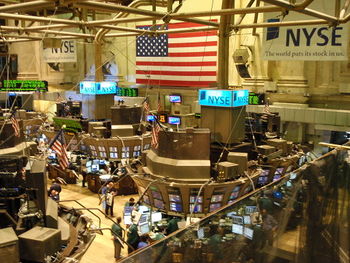Asset

An asset is a store of value that has the ability to provide benefit in the future to the person, firm or government that owns the asset. Assets are bought, sold or created by an entity so that over time, will yield some form of benefit, a higher value, more efficiency etc.[2] There are many types of assets, stocks, bonds, equipment, buildings, people and the skills they possess. Assets can increase in value or decrease in value over time.
There are a number of classifications for assets:
Tangible
A physical asset, that can be touched and manipulated such as a computer, building, machine and even shares in a firm.[3]
Intangible
An asset that cannot be seen or touched such as, intellectual property (patent, trademark, copyright) and effective business strategies. A firm might hire a person because the asset the possess is their intelligence with regards to the industry the firm operates in.[4]
Liquid
An asset that can be converted into cash (or are cash) in very little time. A share in a company can be sold daily (when the market is open) whereas a long-term bond is only converted when it meets the maturity date (a set number of years).[5][6]
Illiquid
An asset that cannot be easily converted into cash such as a house. A house or building cannot be sold quickly and the price that the house will sell for is uncertain and difficult to predict.[7][8]
Financial Assets
These are technically a sub-set of tangible assets but they are distinct as they are generally liquid. Some examples are: cash, stocks/company shares, bonds, convertible bonds, bank deposits etc.[7]
Asset Class
Assets are put in to classes depending on what characteristics they share with other assets and how they behave in the market. For example, stocks or company shares tend to be liquid, tangible or fluctuate often and have some risk whereas a house is tangible, illiquid and very low risk.[9] There are three main classes:
- Stocks or Equities[10][11]
- The purchase of a company share entitles the purchaser to share in the profits of the firm.
- The purchaser also shares in the losses of the company making this class somewhat risky.
- Despite the variable level of risk in the short-term, stocks and equities tend to outperform other asset classes in the long-run.
- Bonds and Fixed Income[10][12]
- This class typically requires a set purchase price and pays out a certain amount overtime.
- This class is purchased for a set amount of time, when it expires or matures the amount it was bought for is paid back to the purchaser.
- This class tends to be a less risky form of asset to hold as they fluctuate less but they also offer a lower rate of return than stocks or equities.
- Cash Equivalent[10]
- This class tends to consist of bank deposits, treasury bills and certificates of deposit.
- While this class is the most secure, it is also the least profitable.
- The rate of return tends to be so low that if inflation rises it can eat into or negate any increase in value.
- This class is also the most secure because many governments guarantees this type of asset, meaning if something goes wrong with the institution that holds it, the government will ensure the investor recovers their money.
Asset Mix
The collection of assets owned by one entity is called a portfolio. Generally the best way to ensure the success of a portfolio to to diversify the portfolio across different asset classes and types of investments. This is done to both ensure a good pay out and to avoid losing money with riskier investments. The different investments that make up a portfolio is called the asset mix.[13] The practice of generating an asset mix that avoids too much risk while trying to maximize the returns to the investor is called portfolio diversification.[14]
For example, if an investor put all of their money into the stock of one company and the company went bankrupt then the investor would lose all of his money. But if the investor only put 10% of his money in that stock of both a variety of other investments such as bonds and real estate then if the same firm went bankrupt the investor would only lose 10% of his money. In the investment market, usually the higher return on an investment, the riskier it is, conversely the lower the return, the less risk there is. A good asset mix and diverse portfolio is a way to try and mitigate risk while maximizing return. [15]
References
- ↑ Wikimedia Commons. [Online], Available: By Ryan Lawler - Own work, Public Domain, https://commons.wikimedia.org/w/index.php?curid=4577893 [Aug 28, 2016]
- ↑ Investopedia. "Asset." [Online], Available: http://www.investopedia.com/terms/a/asset.asp?ad=dirN&qo=investopediaSiteSearch&qsrc=0&o=40186 [Aug 28, 2016].
- ↑ J.Black, N. Hashimzade, and G. Myles. (2009) "Tangible Asset." [Online], Available: http://www.oxfordreference.com/view/10.1093/acref/9780199237043.001.0001/acref-9780199237043-e-3061?rskey=Xr7x7Q&result=8, 2009 [Aug 28, 2016]
- ↑ Investopedia. "Intangible Asset." [Online], Available: http://www.investopedia.com/terms/i/intangibleasset.asp?ad=dirN&qo=investopediaSiteSearch&qsrc=0&o=40186 [Aug 28, 2016].
- ↑ J.Black, N. Hashimzade, and G. Myles. (2009) "Liquid Assets." [Online], Available: http://www.oxfordreference.com/view/10.1093/acref/9780199237043.001.0001/acref-9780199237043-e-1819?rskey=2vQqW1&result=12, 2009 [Aug 28, 2016]
- ↑ Investopedia. "Liquid Asset." [Online], Available: http://www.investopedia.com/terms/l/liquidasset.asp?ad=dirN&qo=investopediaSiteSearch&qsrc=0&o=40186 [Aug 28, 2016].
- ↑ 7.0 7.1 R. A. Brealey et al. Fundamentals of Corporate Finance. Toronto: McGraw-Hill Ryerson, 2012, pp. 775.
- ↑ Investopedia. "Illiquid." [Online], Available: http://www.investopedia.com/terms/i/illiquid.asp?ad=dirN&qo=investopediaSiteSearch&qsrc=0&o=40186 [Aug 28, 2016].
- ↑ Investopedia. "Asset Class." [Online], Available: http://www.investopedia.com/terms/a/assetclasses.asp?ad=dirN&qo=investopediaSiteSearch&qsrc=0&o=40186 [Aug 28, 2016].
- ↑ 10.0 10.1 10.2 SEC. "Beginners' Guide to Asset Allocation, Diversification, and Rebalancing." [Online], Available: https://www.sec.gov/investor/pubs/assetallocation.htm, Aug 28, 2009 [Aug 28, 2016].
- ↑ J.B. Taylor. Economics. Boston: Houghton Mifflin Company, 1995, pp. 424-425.
- ↑ J.B. Taylor. Economics. pp. 426-427.
- ↑ Investopedia. "Asset Mix." [Online], Available: http://www.investopedia.com/terms/a/asset-class-breakdown.asp [Aug 28, 2016].
- ↑ R. A. Brealey et al. Fundamentals of Corporate Finance. pp. 318.
- ↑ J.Black, N. Hashimzade, and G. Myles. (2009) "Diversification." [Online], Available: http://www.oxfordreference.com/view/10.1093/acref/9780199237043.001.0001/acref-9780199237043-e-864?rskey=pPgtvz&result=1, 2009 [Aug 28, 2016]

